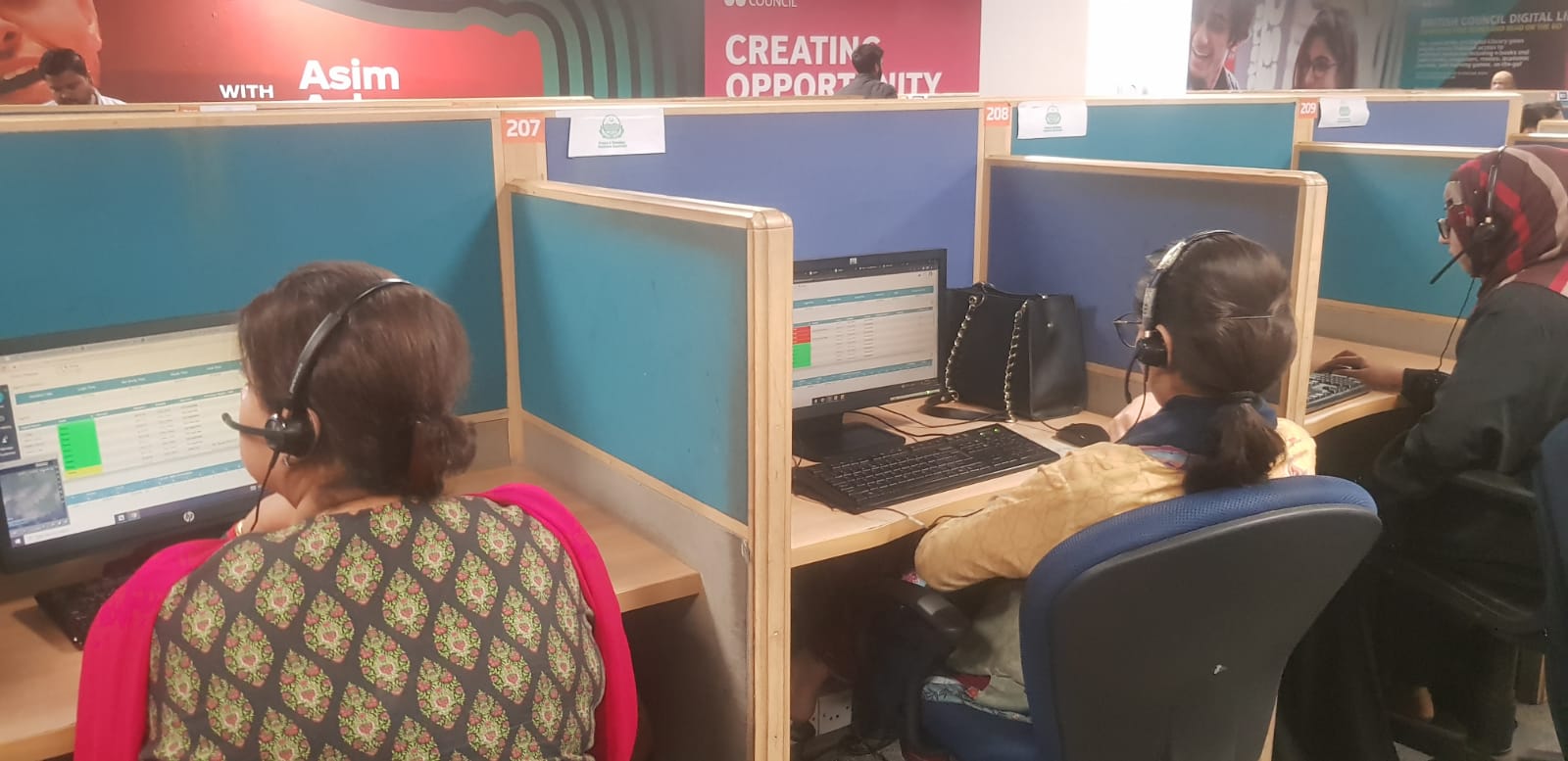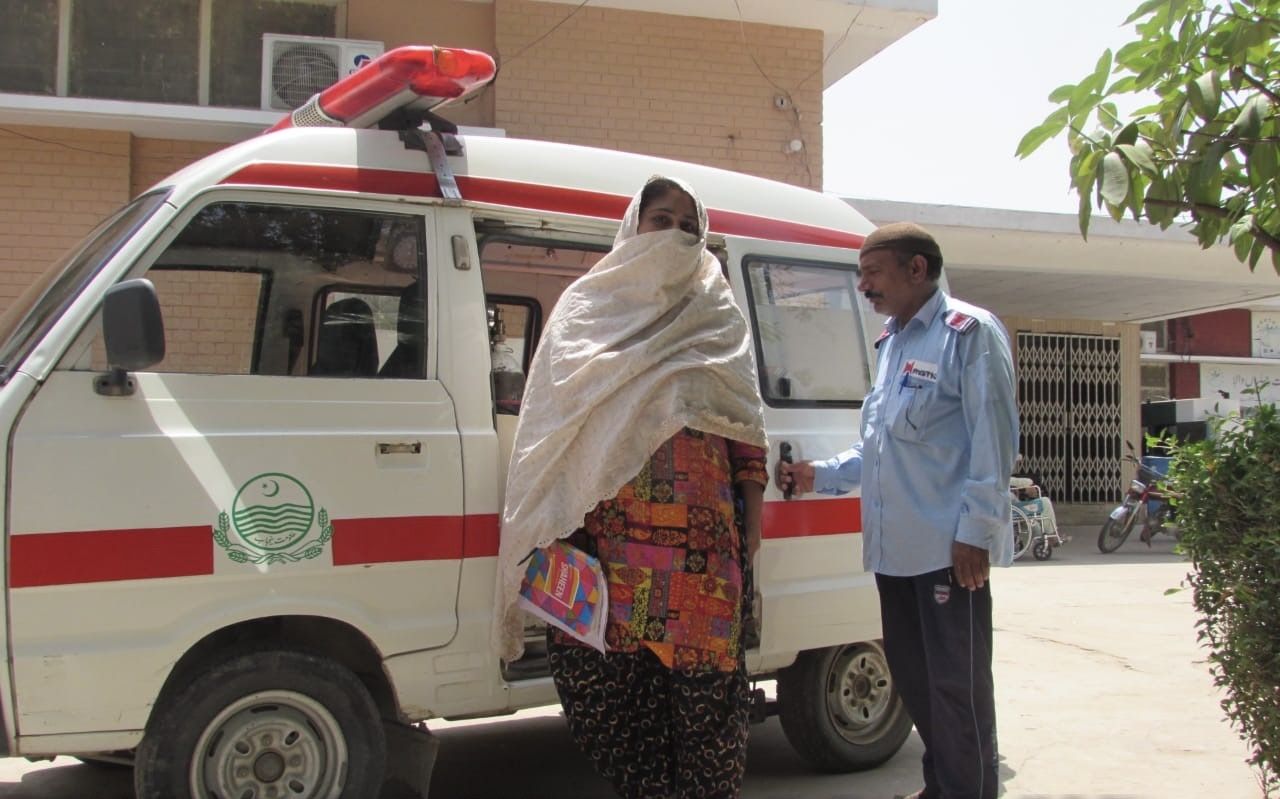It’s time. A pregnant woman in Punjab, Pakistan, dials 1-0-3-4, toll-free. Her journey to safe childbirth has been complicated by a lack of transportation. She is connected to a call centre in Lahore that receives 5000 calls a day from pregnant women and their caregivers in need of transportation for delivery or antenatal complications. The call centre was established in 2017 and currently employs 87 call agents. Utilizing Google maps, GPS trackers and text messaging, the call centre operator dispatches a driver to collect labouring women from their homes and transfers them to a primary care centre, where they will deliver their babies with access to interventions to ensure healthy beginnings for both mother and baby.

Call agents in Lahore processing calls and dispatching drivers. © RAS Call Center Lahore / IRMNCHN Program
In 2007, the maternal mortality ratio in Punjab was 227 deaths per 100 000 live births. This was a result of poor socio-economic conditions, challenges in accessing health care in rural areas, and a lack of decision-making power among young women. At the time, approximately 30% of maternal deaths in Pakistan were attributable to delays in reaching health-care facilities, with many women facing long travel distances to give birth as well as lack of access to transportation.
Over the last two decades, the Government of Punjab has scaled up around 2500 basic health units and equipped 1800 with 24-hour basic obstetric care services. These basic units, the country’s first-level health-care facilities, play a crucial role in addressing maternal and child health issues, especially in rural areas where access to health care is limited. Based on the 2023 census, nearly two thirds of Pakistan’s population resides in rural areas.
Under the national universal health coverage essential package of health services, the Government of Punjab has now funded a fleet of over 600 ambulances to transport pregnant women from their homes in rural areas to birth centres for delivery. The same service also transports sick children (under age 5 years) for urgent medical care. On average, the rural ambulance service transports 2800 women each day across the province, including public holidays. The cost per transfer for a typical case is approximately US$ 10–15. The service is vital for the more than 30% of pregnant women in Punjab who cannot reach health facilities for safe delivery. Without the service, they would be forced to deliver at home, without access to emergency obstetric and neonatal care.
"We promote the rural ambulance service through a combination of community outreach and public awareness campaigns. We visit homes, hold community meetings, and distribute informational materials to ensure that every pregnant woman knows about the toll-free number 1-0-3-4 and how to access the service. During the first antenatal care visit, the staff facilitates the registration of pregnant women for the ambulance service. Their personal touch and deep knowledge of their respective communities make a significant difference in spreading the word effectively," said Saeeda Khan, Lady Health Worker, Ali Raza Abad, Lahore.
The government’s Integrated Reproductive, Maternal and Child Health & Nutrition Programme oversees the technical and financial aspects, while the central call centre and daily operations are managed by a telecom operator and a private car rental company, respectively. The rental company supplies fuel, drivers and maintains the ambulance, with performance tracked via a dashboard that requires the engine to start within two minutes of case assignment.

A pregnant women arriving at a rural health centre in Challian Wala, Punjab to safely deliver her baby. © RHC Challian Wala / M.B. Din
The real-time dashboard shows GPS-tracked ambulance locations, allowing call centre operators to assign the nearest vehicle to waiting women and their caregivers. Once assigned, both the driver and the woman receive a call and a text message with their respective contact information. The text messages enable communication between drivers and women and allow drivers to pinpoint exact addresses, a task that is often difficult in rural areas.
"We prioritize calls based on the urgency of the situation, with high-risk pregnancies and emergencies at the top of the list. If a connection drops or a phone battery dies, our system automatically sends text messages to both the driver and the client, ensuring they can still communicate. Additionally, Lady Health Workers and Skilled Birth Attendants are always ready to step in and provide support, ensuring that no woman is left without assistance,” said Bilal Ahmed, District Transport Officer, Outsourced Management Firm.
Since its debut in 2017, the ambulance service has facilitated the transport of over 3 million women from their homes to health facilities, approximately three and a half million women from primary care to secondary or tertiary hospitals, and around 10 000 children for urgent referrals. It is estimated that at least half of the 500 000 emergency referrals to secondary and tertiary care hospitals have effectively prevented severe morbidity and mortality among mothers and newborns in Punjab.
"Without the rural ambulance service, my birth experience would have been incredibly stressful and risky. I would likely have had to deliver at home without skilled medical assistance, which could have jeopardized both my health and my baby's. The timely support from Lady Health Workers and Skilled Birth Attendants ensured that I received quality care and safe delivery at a health facility. Their presence and the ambulance service made all the difference,” said Keenza Faisal, Beneficiary, Allama Iqbal Town, Lahore.
Today, there are 157 maternal deaths for every 100 000 live births in Punjab, a decrease of more than 30% from 2007. This decrease has resulted from interventions related to improved access to maternal health services, in addition to addressing the underlying causes for maternal deaths – for instance, through improved access to family planning.
Still, there is work to be done.
Removing barriers like discriminatory social norms, financial constraints and limited decision-making power for women is essential to advancing maternal and newborn health outcomes.
“Sustainable progress demands more than just service delivery: health systems must address gender inequalities, strengthen sexual and reproductive health and rights, and ensure equitable access to quality emergency obstetric and newborn care, particularly in rural and underserved areas. Removing barriers like discriminatory social norms, financial constraints and limited decision-making power for women is essential to advancing maternal and newborn health outcomes,” said Ellen Mpangananji Thom, Deputy WHO County Representative, Pakistan.
This story was originally brought to life on the WHO-UNFPA Learning by Sharing Portal (LSP), which highlights the critical work of various stakeholders in improving access to sexual and reproductive health and rights services within the broader context of universal health coverage. The LSP seeks to create a repository of implementation stories on effective health system interventions and serves as a valuable resource for shared learning, advocacy and capacity building at global, regional and country levels.
In follow up to World Health Day, please join the WHO-UNFPA Learning by Sharing Portal (LSP), WHO Pakistan, and the Primary & Secondary Healthcare Department, Punjab, Pakistan, on 9 April at 13:00 CET for an interactive discussion with experts and implementers involved in the roll out of the rural ambulance service in Punjab, Pakistan. Please register for the event here. If you have questions for the implementers, please submit them here.
